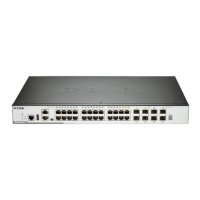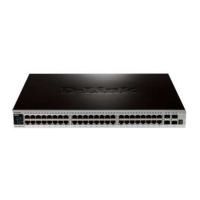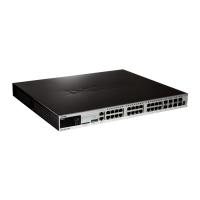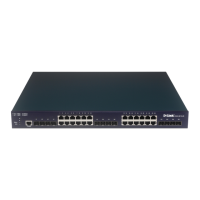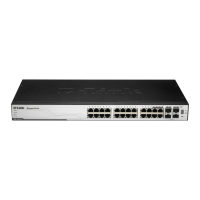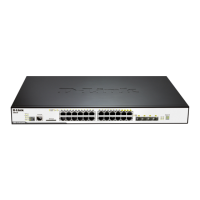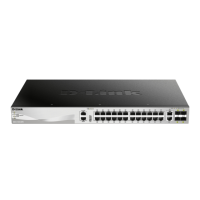DGS-3630 Series Layer 3 Stackable Managed Switch Hardware Installation Guide
47
Connecting to the MGMT Port
The front panel of the Switch features an Out-Of-Band (OOB) RJ45 MGMT port which can be used to connect to a
computer using a standard Ethernet cable. A web browser or Telnet client can be used to connect to the Switch using
the MGMT port.
To use the MGMT port, connect one end of an Ethernet cable to a computer and the other end to the Switch. The
default IP address of the MGMT port is 192.168.0.1 and the subnet mask is 255.255.255.0. Make sure that the
computer being used for the switch management has a non-conflicting IP address in the 192.168.0.0/24 network.
To view the IP settings of the MGMT port, use the following command:
Switch#show ip interface mgmt 0
mgmt_ipif 0 is enabled, Link status is up
IP address is 192.168.0.1/24
Gateway is 0.0.0.0
Switch#
The IP settings or enabled status of the MGMT port can be changed through the console port. For example, to change
the IP address of the MGMT port, use the following commands:
Switch#configure terminal
Switch(config)#interface mgmt 0
Switch(config-if)#ip address 192.168.1.1 255.255.255.0
Switch(config-if)#
Connecting using SNMP
The Simple Network Management Protocol (SNMP) is an OSI Layer 7 (Application Layer) protocol designed
specifically for managing and monitoring network devices. SNMP enables network management stations to read and
modify the settings of gateways, routers, switches, and other network devices. Use SNMP to configure system
features for proper operation, monitor performance, and detect potential problems in the Switch, switch group, or
network.
Managed devices that support SNMP include software (referred to as an agent), which runs locally on the device. A
defined set of variables (managed objects) is maintained by the SNMP agent and used to manage the device. These
objects are defined in a Management Information Base (MIB), which provides a standard presentation of the
information controlled by the on-board SNMP agent. SNMP defines both the format of the MIB specifications and the
protocol used to access this information over the network.
The Switch supports SNMPv1, SMNPv2c, and SNMPv3. The administrator may specify which SNMP version to use to
monitor and control the Switch. The three SNMP versions vary in the level of security provided between the
management station and the network device.
In SNMPv1 and SNMPv2c, user authentication is accomplished using 'community strings', which function like
passwords. The remote user SNMP application and the Switch SNMP must use the same community string. SNMP
packets from any station that has not been authenticated are ignored (dropped).
The default community strings for the Switch used for SNMPv1 and SNMPv2c management access are:
public - Allows authorized management stations to retrieve MIB objects.
private - Allows authorized management stations to retrieve and modify MIB objects.
SNMPv3 uses a more sophisticated authentication process that is separated into two parts. The first part is to
maintain a list of users and their attributes that are allowed to act as SNMP managers. The second part describes
what each user on that list can do as an SNMP manager.
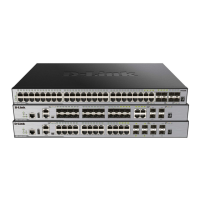
